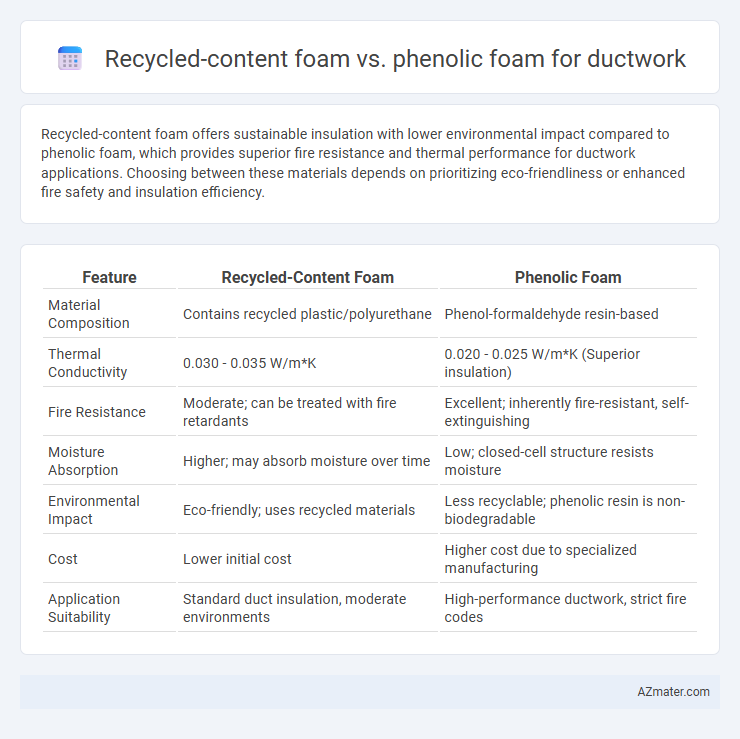Recycled-content foam offers sustainable insulation with lower environmental impact compared to phenolic foam, which provides superior fire resistance and thermal performance for ductwork applications. Choosing between these materials depends on prioritizing eco-friendliness or enhanced fire safety and insulation efficiency.
Table of Comparison
| Feature | Recycled-Content Foam | Phenolic Foam |
|---|---|---|
| Material Composition | Contains recycled plastic/polyurethane | Phenol-formaldehyde resin-based |
| Thermal Conductivity | 0.030 - 0.035 W/m*K | 0.020 - 0.025 W/m*K (Superior insulation) |
| Fire Resistance | Moderate; can be treated with fire retardants | Excellent; inherently fire-resistant, self-extinguishing |
| Moisture Absorption | Higher; may absorb moisture over time | Low; closed-cell structure resists moisture |
| Environmental Impact | Eco-friendly; uses recycled materials | Less recyclable; phenolic resin is non-biodegradable |
| Cost | Lower initial cost | Higher cost due to specialized manufacturing |
| Application Suitability | Standard duct insulation, moderate environments | High-performance ductwork, strict fire codes |
Introduction to Duct Insulation Materials
Recycled-content foam and phenolic foam serve distinct roles in duct insulation, with recycled-content foam offering enhanced sustainability through the use of post-consumer materials and phenolic foam providing superior thermal resistance and fire retardancy. Both materials contribute to energy efficiency in HVAC systems by reducing heat loss and preventing condensation within ductwork. Selecting the appropriate insulation balances environmental impact, thermal performance, and compliance with building codes for optimal ductwork longevity and system efficiency.
Overview of Recycled-Content Foam
Recycled-content foam for ductwork offers sustainable insulation by incorporating post-consumer and industrial waste materials, reducing environmental impact compared to traditional options. This foam type typically exhibits high thermal resistance and good moisture resistance, enhancing energy efficiency and indoor air quality. Its lightweight nature and ease of installation make it a practical choice for HVAC systems seeking eco-friendly alternatives without compromising performance.
Phenolic Foam: Properties and Applications
Phenolic foam offers superior thermal insulation with low thermal conductivity (around 0.022 W/m*K), excellent fire resistance, and low smoke emissions compared to recycled-content foam, making it ideal for ductwork in commercial and industrial HVAC systems. Its closed-cell structure provides high compressive strength, moisture resistance, and long-term dimensional stability, ensuring durability in demanding environments. Phenolic foam's antimicrobial properties and compliance with stringent building codes further enhance its application in cleanroom ventilation and energy-efficient building designs.
Environmental Impact: Recycled vs Phenolic Foam
Recycled-content foam significantly reduces landfill waste by incorporating post-consumer materials, lowering overall environmental impact compared to phenolic foam, which relies on petrochemical resources and exhibits higher embodied carbon. Phenolic foam, while offering superior fire resistance, involves energy-intensive manufacturing processes that increase greenhouse gas emissions. Choosing recycled-content foam in ductwork supports sustainable building practices by enhancing resource efficiency and minimizing carbon footprint.
Thermal Performance Comparison
Recycled-content foam typically offers moderate thermal insulation with R-values around 4 to 5 per inch, while phenolic foam delivers superior thermal performance, boasting higher R-values often exceeding 6 per inch. Phenolic foam's closed-cell structure minimizes air permeability and thermal bridging, making it more effective in maintaining ductwork temperature and reducing energy loss. Selection of phenolic foam can lead to enhanced HVAC system efficiency and lower operational costs compared to recycled-content foam.
Fire Resistance and Safety Standards
Recycled-content foam and phenolic foam differ significantly in fire resistance and safety standards for ductwork applications. Phenolic foam offers superior fire retardancy with a low flame spread index, self-extinguishing properties, and minimal smoke production, making it compliant with stringent fire safety codes such as ASTM E84 Class A. Recycled-content foam generally exhibits lower fire resistance, often requiring additional treatments or barriers to meet comparable safety standards in HVAC duct systems.
Installation and Handling Differences
Recycled-content foam offers enhanced flexibility and lighter weight, simplifying the installation process by reducing handling fatigue and cutting labor time on ductwork projects. Phenolic foam, known for its rigid structure and brittle nature, requires careful handling to prevent cracking or damage during installation, often resulting in longer setup times. The differing material properties significantly impact ease of use, with recycled-content foam providing a more user-friendly option for complex duct configurations.
Cost Analysis: Initial and Lifecycle
Recycled-content foam offers a lower initial cost compared to phenolic foam, making it a budget-friendly option for ductwork insulation projects. Phenolic foam, while more expensive upfront, provides superior thermal performance and fire resistance, which can reduce long-term energy and maintenance costs. Lifecycle cost analysis typically favors phenolic foam due to its durability, lower operational expenses, and extended service life, despite the higher initial investment.
Sustainability and Certification Considerations
Recycled-content foam enhances sustainability in ductwork by utilizing post-consumer materials, reducing landfill waste and conserving natural resources, while phenolic foam offers superior fire resistance and thermal insulation with certifications such as GREENGUARD Gold and UL 94. Both materials contribute to LEED credits, but recycled-content foam excels in embodied carbon reduction whereas phenolic foam provides compliance with stringent fire safety standards. Selection depends on project priorities including EPA waste diversion goals, ASTM E84 flame spread ratings, and regional green building codes.
Choosing the Right Foam for Your Ductwork
Recycled-content foam offers an eco-friendly option for ductwork insulation with good thermal performance and lower environmental impact due to its sustainable materials. Phenolic foam provides superior fire resistance and excellent thermal insulation, making it ideal for commercial duct systems requiring stringent fire codes compliance. When choosing the right foam for your ductwork, consider factors such as fire rating, thermal conductivity, environmental sustainability, and installation requirements to ensure optimal performance and safety.

Infographic: Recycled-content foam vs Phenolic foam for Ductwork
 azmater.com
azmater.com